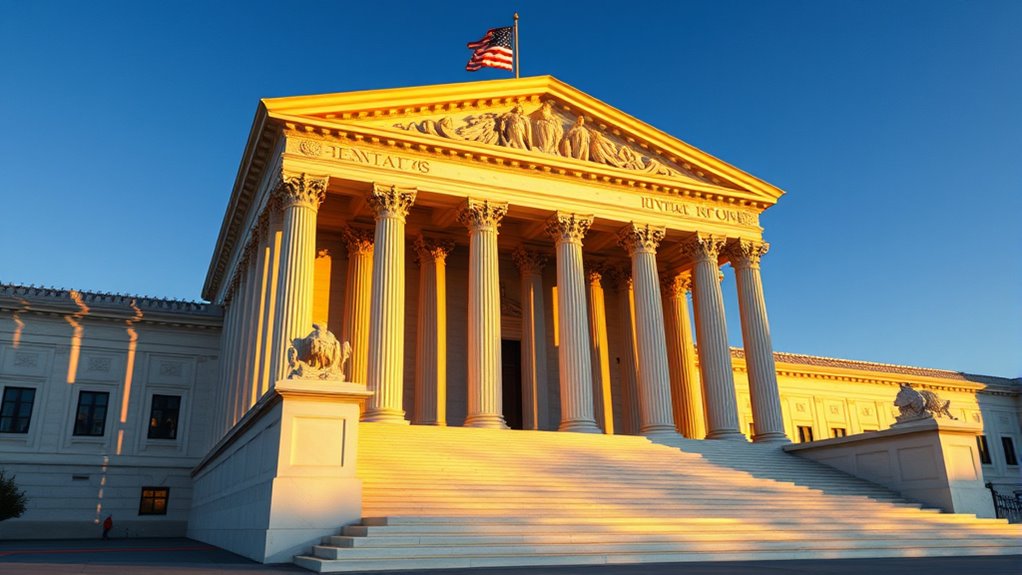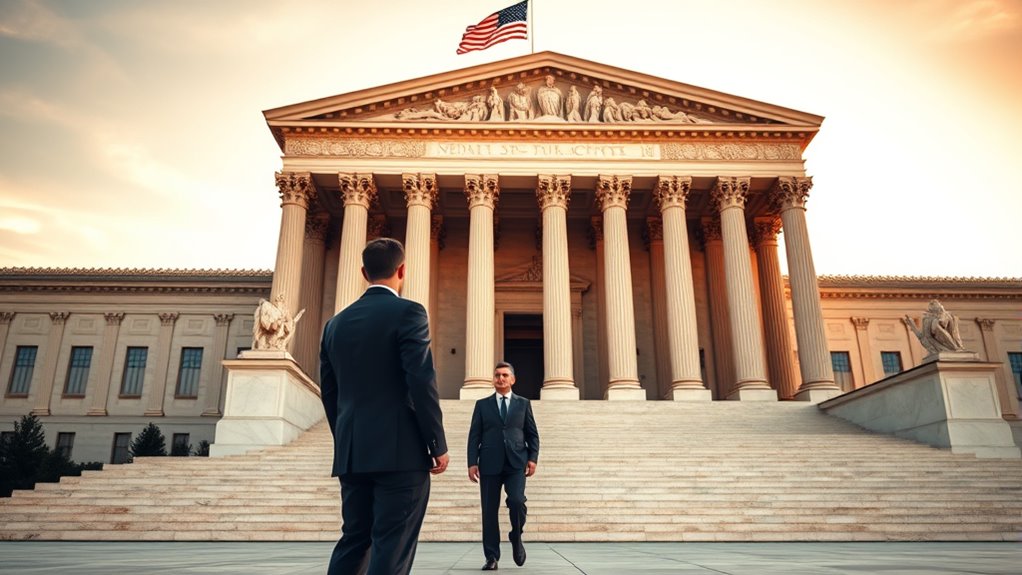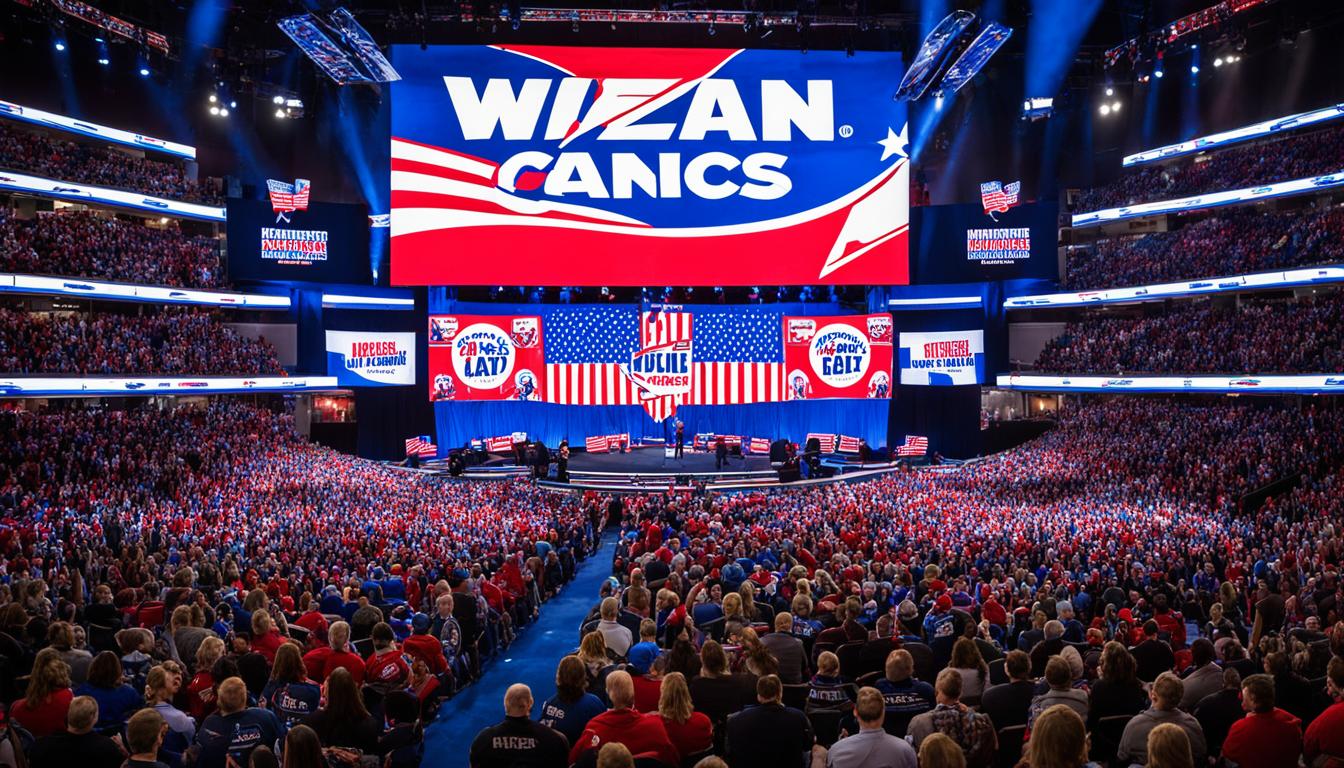In the 2025-26 Supreme Court term, key cases to watch include disputes over voting rights, gun control, and religious freedoms, as the Court’s new ideological makeup influences its stance on these issues. You’ll see debates on overturning longstanding precedents and interpreting constitutional protections amid societal changes. Understanding the justices’ philosophies can help you anticipate rulings that could reshape laws affecting daily life. Stay with us to uncover more about what’s likely to unfold.
Key Takeaways
- Anticipated rulings on voting rights could reshape electoral laws amid changing Court ideological balance.
- Cases addressing gun control will reflect the Court’s stance on Second Amendment protections.
- Litigation on religious freedoms and conflicts with LGBTQ rights may test judicial interpretations.
- Technology-related cases on AI regulation and privacy rights will influence future legal standards.
- Disputes over federal versus states’ powers are likely to highlight ideological differences in constitutional interpretation.

As the 2025-26 Supreme Court term begins, shifts in the bench and emerging legal controversies promise to shape the nation’s legal landscape. One of the most significant factors influencing these changes is the ongoing process of judicial appointments. With new justices joining the Court, you can expect a noticeable shift in the Court’s ideological balance. These appointments are not just about filling vacancies—they reflect a deliberate effort to influence how the Court interprets the Constitution for years to come. As new justices are confirmed, their judicial philosophies will shape the Court’s approach to constitutional interpretations, affecting rulings on hot-button issues like voting rights, gun control, and religious freedoms.
You should pay close attention to how these appointments impact the Court’s composition and its stance on constitutional law. Appointments tend to skew the Court’s direction, especially when justices are selected based on their conservative or liberal leanings. These choices influence the Court’s willingness to overturn precedents, interpret statutes, and assess the scope of federal power versus states’ rights. The ability of justices to influence constitutional interpretations over time makes their appointments a pivotal factor in shaping legal doctrine. As the Court grapples with complex legal questions, the ideological makeup established through judicial appointments will determine whether the Court adopts a broad or narrow view of constitutional protections.
Furthermore, the Court’s approach to constitutional interpretations will be central to many key cases this term. Justices will debate whether to adopt originalist or living constitutionalist perspectives, which drastically alter how laws are evaluated. Originalists focus on the text and original intent of the Constitution, while living constitutionalists believe the document should evolve with societal changes. This divergence influences rulings on issues like free speech, privacy rights, and equality. For you, understanding the Court’s interpretive methods will be essential in predicting outcomes on controversial issues. The way justices interpret the Constitution will directly impact the legal landscape, shaping laws and policies that affect everyday life. Additionally, ongoing AI safety concerns and technological advancements could influence certain legal debates this term, especially regarding privacy and regulatory authority.
Frequently Asked Questions
How Are Supreme Court Justices Appointed for the 2025-26 Term?
You see that judicial appointments for the 2025-26 term happen through a nomination process where the President selects a candidate, and then the Senate confirms or rejects them. This process involves hearings, evaluations, and votes to make certain the appointee is qualified. The goal is to pick justices who align with the judiciary’s needs, making the nomination process a critical step in shaping the Court’s future.
What Are the Potential Impacts of Upcoming Cases on Constitutional Rights?
Upcoming cases could substantially impact your constitutional rights, especially regarding the First Amendment and privacy rights. You might see rulings that shape free speech protections or set new limits on government surveillance. These decisions could influence what you can express publicly and how your personal information is protected. Staying informed helps you understand how these cases might affect your daily freedoms and privacy, shaping the legal landscape for years to come.
How Does the Court Select Cases for This Term?
About 7,000 cases are filed each year, but the court only selects around 70 to 80 for review. You’ll see that case selection hinges on jurisdiction criteria, focusing on cases with significant legal or constitutional questions. The justices carefully evaluate petitions, considering factors like circuit conflicts and importance. This process guarantees only the most impactful cases reach the bench, shaping the law for years to come.
What Are the Major Legal Issues at Stake This Term?
This term’s major legal issues center on legal controversies like free speech, voting rights, and technology regulation. You’ll see the Court prioritize cases that challenge existing laws and expand judicial influence. By focusing on these topics, the Court aims to address societal shifts and clarify legal standards. Your understanding of these issues will deepen as the Court’s decisions shape national policy and influence future legal debates.
How Might Recent Political Changes Influence Court Decisions?
Recent political changes could influence court decisions by increasing political influence or threatening judicial independence. You might see justices feeling pressure from political parties or public opinion, which could sway rulings on controversial issues. However, it’s important for the court to maintain judicial independence to uphold fairness. Staying aware of these dynamics helps you understand how politics could shape legal outcomes this term.
Conclusion
As you follow the upcoming Supreme Court term, remember these key cases will shape your rights and society. Some might worry the Court will lean one way or another, but staying informed guarantees you understand the legal landscape. Don’t dismiss the impact of these decisions—your engagement and awareness can influence how they’re interpreted and applied. Stay attentive, because what happens in these rulings could truly affect your future in ways you might not expect.










